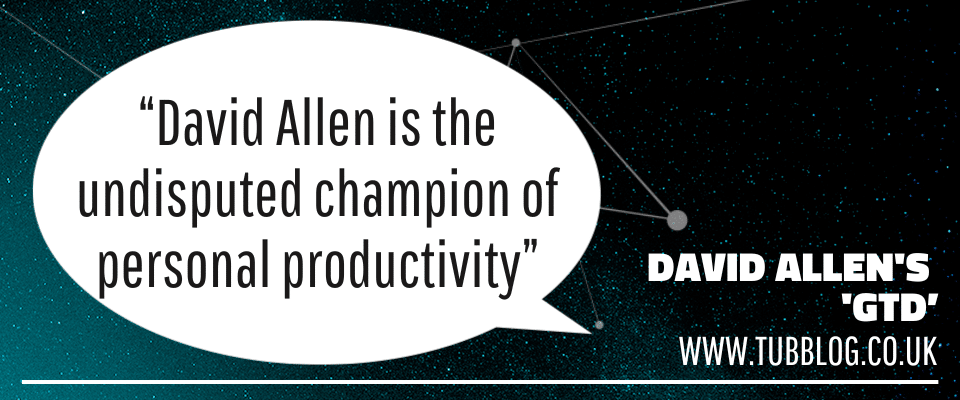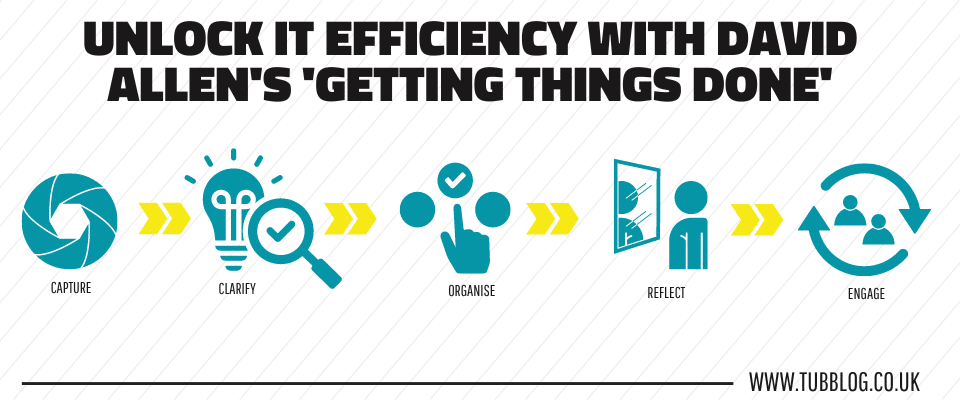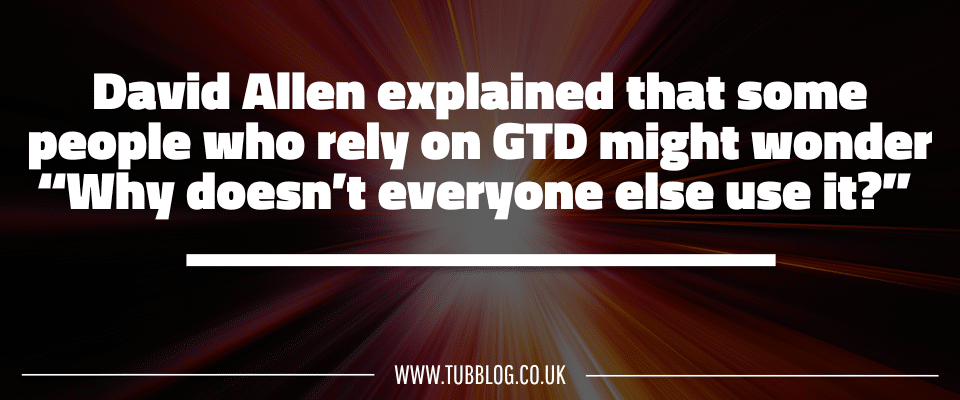Ever struggled with keeping productive? Feel like you’re sinking in an ever-rising river of emails, admin, and client tasks – without feeling like you’re getting anywhere fast?
Chances are, lots of you are nodding along. In the IT industry, we’re all used to expecting the unexpected. We’ll start the day off with a clear list of tasks and to-dos, only to find a whole host of tech demands flying from all angles, setting us off-balance.
Now – if you enjoy working in IT and tech, chances are you thrive on chaos. But, does that necessarily mean you’re being productive?
If you’ve been a long-time reader of Tubblog, you might already know that Richard strongly supports the GTD method – Getting Things Done, created by productivity maestro David Allen.
Allen’s 2001 book of the same name explores ways in which we can all stay productive while balancing stress. It’s all about attacking that initial source of stress and logically examining trigger points.
Richard and David have chatted twice about productivity and the modern IT workplace via Tubbtalk – and, recently, David’s announced the release of a follow-on from GTD – Teams: Getting Things Done With Others.
In this guide, I’ll give you an introductory tour of Getting Things Done, its follow-up, and how David’s fantastic insights are helping IT professionals manage increasingly chaotic workloads with poise and confidence.
What is it about David Allen’s work that resonates so much with IT and tech professionals? Let’s take a deep dive and find out.
Who is David Allen?
David Allen is the undisputed champion of personal productivity. Over the past three decades, he’s helped corporate leaders and CEOs worldwide master daily organisation and make the dreaded overwhelm more manageable.
In the IT industry, finding balance has never been more important – and David’s techniques are helping millions of tech experts carefully manage daily projects alongside ad-hoc requests without burning out.
His 2001 book, the aforementioned Getting Things Done, put David’s work on the map. In the years since its release, the researcher and coach has been recognised by Time Magazine and Business 2.0, and has made it to the top of international best-sellers’ lists.
But what’s David’s thought process behind creating GTD in the first place? How does he break it down into a few words – if that’s even possible?
In conversation with Richard over on TubbTalk, he describes the GTD concept as “really simple, basic moves that everybody knows how to do.”
“It’s a sort of ‘best practices’ that are simple to do, but they don’t happen automatically,” he explains. “If you learn to do them, and do them consistently, it creates more of a sense of control, more of a sense of focus – and creates more cognitive space to focus on whatever you consider the most meaningful things.”
David explains that GTD is all about “getting stuff out of your head without having to finish it,” then engaging with it and “freeing up your head to do what it does much better (…) than try to remember and remind.”
“Deciding what to do actually takes thinking and decision-making,” David says. “So, I just figured – what’s the thinking process, and the decision-making process, you need to apply to that email, letter or idea you came up with – in order to be able to then get those out of your head and actually make them much easier to engage with?”
David essentially realised his own head was unclear and that he needed to “fix” it. Clearly, his methodologies have worked well for millions – over 20 years on, he’s still regarded as the father of modern productivity.
But, what exactly does GTD involve, and how can IT professionals apply it to their increasingly complex workloads? Let’s dig a bit deeper.
What is “Getting Things Done?”
David developed the GTD system over the years to apply to people from all walks of life and to use across the industries – it just so happens it’s really caught on with tech and IT experts.
Ultimately, GTD is all about siphoning ideas away from your mind, so you can use it to create, rather than store endless tasks and worries.
From there, you can use GTD to record and break down the tasks from your head into tangible, bite-sized steps. That might sound like it’s just about writing lists – that’s some of the work behind GTD, but the secret spice behind it all is learning how to spot and focus on the next actions you need to take.
GTD is a procrastination killer in that it clearly tells you what steps to take rather than leave tasks vaguely piling up. How often have you put off jobs or tasks simply because they appear too large, complex, or vague to break down?
Getting Things Done, according to David, is breaking down these larger tasks into smaller stepping stones. For example, what steps might you need to take when fortifying a client’s LAN security for the first time? Instead of looking at the mountain, you look at the rocks you need to climb to get to the summit.
Store these stepping stones (or rocks, if we continue the metaphor) externally, and your mind can focus on actually taking action.
The GTD workflow
Richard’s talked about the GTD workflow briefly elsewhere on Tubblog, but let’s revisit the concept and break down each of the steps in detail. Not to spoil David’s book, let’s look at each of the five main components of a GTD system and consider how we can apply them to certain IT or tech demands.
The typical or hypothetical GTD workflow or system splits into five key stages:
- Capture
- Clarify
- Organise
- Reflect
- Engage
Here’s what those points all mean in practice:
Capture
Capture is stage one, and it’s all about recording what’s on your mind. What’s making you worry? What problems are at the forefront of your mind, and what do you need to take off your plate?
David suggests getting anything that doesn’t have a logical conclusion into a physical system where you can store it and break it down. That might be a notepad, an inbox, or even a reminder or two in a phone app. You might even benefit from recording your thoughts verbally, again, with an app or a memo recorder.
This stage lets you take immediate problems off your mind so you can start breaking them down. For example, you might worry about configuring a complex cloud infrastructure for a new client. Get that captured!
Clarify
The clarify stage is where you examine the concerns you recorded and decide what they mean. In the next stage, you organise them into different buckets so it’s easier to know what to prioritise.
At the clarify stage, you ask yourself “what is it?” Is your concern or task something you can take action on right away, or can you ‘throw it away’?
This is the process of ‘emptying your inbox’. If your task is something you can take action on, or should take action on, you could:
- Just do it (if it takes less than two minutes)
- Delegate it (if there’s someone who can handle the work for you)
- Move it along (if you can do it later)
If it’s a task or action that isn’t a priority or might even be in doubt, you could:
- Throw it away
- Save it for later
- File it clearly so you can address it quickly another time
This is going to mean you need to think deeply about each of the tasks on your mind – and David explores this in plenty of detail in his book, helping you break down your concerns into tangible steps.
Organise
Now you know what each of your worries or tasks are, and how you intend to prioritise them, it’s time to organise a plan of attack.
It’s here where you take your tasks out of your inbox and start putting them in action buckets that make logical sense.
For example, you should be careful to distinguish between projects, ideas, and individual activities. Projects are long-term tasks that you can break down into separate stages and add to your calendar or priority to-do lists.
At the organise stage, it’s important to start adding dates for delivery to your calendar, save items for later, and decide who can take on certain tasks for you.
David suggests it’s worth organising tasks into ‘projects’, ‘next actions’, ‘waiting for’, and ‘calendar’. You should also take time to assign tasks to a ‘Someday, Maybe’ list, which is where you hold any ideas or potential projects you’d like to do, but which aren’t necessarily priority straight away.
Reflect
The reflect or review stage ensures you check in regularly to ensure your projects move in the right direction. That means keeping lists and buckets up to date and measuring progress. We all love to see progress on paper – it’s a fantastic motivator.
Some people suggest updating buckets and reflecting on progress weekly, though you might instead prefer to record and measure as you go. For some tasks, such as calendar activities, it’s probably worth updating once a day.
Reflecting on your GTD buckets ensures you keep your mind clear of ‘to-do’ clutter so it’s free to get creative. Think of it as moving files from a hard drive to a USB dongle or into the cloud.
Engage
Engage is all about simply doing the tasks you’ve recorded and broken down in the GTD system. It’s easy to overthink this process stage – but fight that urge!
Focus instead on the activities and tasks you’ve listed as a priority, record the results and what you’ve done, and measure your progress regularly. Top your buckets back up with new tasks and ideas when they arise, and keep your mind clear and fresh for creative, engaging work.
As you can see, David’s model is intentionally broad and incredibly scalable. That’s just one reason why it’s so appealing in IT and tech, where projects can soon grow out of hand!
Some GTD users with ADHD even claim the system helps them to keep things in perspective and focus – it’s great for lightening the memory load. However, it’s worth making the distinction that it’s not a catch-all solution for problems you experience through neurodivergency.
How does GTD help with productivity, and why is it so appealing for IT professionals?
Now you know how the GTD system works in practice, let’s look at a few ways it can help you become more productive in IT and tech.
There’s plenty of reasons why IT pros swear by David Allen’s principles. Some suggest the relatively complex yet practical setup of GTD appeals to technically-minded people.
What’s interesting, too, is that despite IT professionals having largely tech-focused mindsets, GTD is built to be tool-free. “The tool solves nothing,” David says. “It’s the thought process that knows how to use the tool.”
Here are a few key reasons why GTD is so appealing to professionals in the IT industry.
It’s highly customisable
GTD is extremely appealing to overworked IT professionals simply because it is not confined to specific timeframes or workload sizes.
Depending on your role, you might have large projects to tackle for external clients one day and smaller jobs to attend to in-house the next.
What’s more, managed IT companies are always scaling up due to increasing demand. GTD is scalable and customisable so that you can keep daily and long-term tasks rolling out of your mind and into external systems for ease of access, no matter what you have on your plate.
It helps you visualise steps up the mountain
As mentioned above, GTD is great at helping IT professionals scale mountainous tasks one stepping stone or rock at a time.
Think about some of the bigger jobs and challenges you might undertake when onboarding new clients. For example, a project or task on your plate might be to audit a client’s cybersecurity.
That’s a monumental task that requires multiple steps. Using the GTD system, you can break this down into stages such as analysing potential threats, checking software currently in place, penetration testing existing security measures, and checking if the client’s personnel have adequate training and knowledge to manage information security on their own.
With GTD buckets, you can siphon each of these tasks out of your mind and focus on creatively working down the most important aspects one by one.
It ensures you always have a next action to take
Working in IT means you’re always up against the unexpected. What problems are your clients likely to face from one moment to the next? Will you need to take emergency actions to remove ransomware, provide server support, or troubleshoot usability concerns at short notice?
In these unexpected moments, the GTD system helps IT professionals see the bigger picture in the blink of an eye. When well-trained and acquainted with GTD, IT pros can reflexively record the actions they need to take and start fixing client problems.
GTD helps IT professionals remove any extraneous or unhelpful clutter from their minds so they can focus on creatively and quickly finding solutions.
This ties in with David’s ideas about the “next action.” With a fluid GTD process, there should be no sticking or stumbling around on one or two points. You’re always ready to be active and productive instead of fumbling around for solutions in your own head. Siphon away that fluff!
You gain control and perspective
As Richard stated via Tubblog, GTD gives you incredible control and perspective over your work. That’s not always easy to find when you’re busy managing multiple demands for several clients at once – even more so in the highly technical IT industry!
IT professionals don’t have the time or luxury to worry about what’s on their plates. Therefore, David proposes you remove the mind fluff and put it on a separate plate – a GTD system – where you can look clearly at what’s at stake and what’s ahead of you.
We all have days where we procrastinate or perhaps focus on the wrong things. However, with GTD, it’s easier for IT pros to look at the bigger picture systematically, and instead preserve their mind for creatively solving problems.
What is ‘Team: Getting Things Done with Others’?
Thanks to the expansion of the Internet and the remote work revolution, we’re living in an age of collaboration.
Therefore, David Allen saw a need to revisit GTD for a new generation – and, some 23 years after the release of his landmark book, ‘Team: Getting Things Done with Others’ explores his principles from a refreshing new perspective. He’s worked on this new volume with Ed Lamont, his British partner on the GTD line.
David talked with Richard earlier this year about the release of his new book, and why he believes it’s important for people to tackle the principles of GTD together, not just apart. The major issue acknowledged is that, while many people apply GTD to their own work, others don’t – and that can make it harder to collaborate on specific projects and deadlines.
He explained that some people who rely on GTD (regardless of industry) might wonder “Why doesn’t everyone else use it?”
“Most of the best practices of Getting Things Done apply to teams,” David explains, saying that the new book is an exploration of how GTD’s main five principles and six horizons of commitment can apply to teams of people at once.
David has also acknowledged the rise of productivity tools in the years since the original GTD book was released. “There was clearly a need for a GTD for teams book,” he says. “But, it was a challenge – because teams are unique in what they do, the people in them, and the experiences they bring.”
The new book applies the same five principles explored back in 2001 – but instead expands them as they apply to teams, as singular entities, with ‘owners’ at the helm.
David and Ed look at what the former refers to as ‘symptoms of dysfunction’ within teams and break down simple steps that groups of people can take to fix root problem causes. It’s about looking at how high-performance teams, as David refers to them, work together to get great results.
The authors dig deep, too, into what they establish as the ‘horizons of commitment’ and how the mind-transferring principles of classic GTD apply when you’re managing several people at once.
The big idea behind GTD and teams is that, to be truly productive and drive great results, people in those teams need to communicate and collaborate clearly. David, in fact, refers to bigger companies often focusing too much on improving efficiency in workflows and not necessarily on individual mental overload.
“You don’t have to be a huge GTDer to get a lot out of this book,” David says. “These are all really the best practices of high-performance teams.”
Could GTD Help You Unlock the Secrets of Productivity?
GTD has changed lives and workloads for people far and wide across the IT industry. It’s easy to think you’ve got a handle on your tasks and that you don’t need another system thrown into the mix – but if you’re in IT and haven’t yet discovered GTD, it’s absolutely worth exploring alongside David and Ed’s new book, ‘Teams’.
GTD does require commitment and some deep analysis about the tasks you have to do – but ultimately, it’s a system that can help give you an easier and more productive life!
David states that you can start with GTD through a variety of systems and resources. You can start transferring your thoughts however you see fit. “Pen and paper, you can’t beat it,” David says. “No Wi-Fi required!”
GTD remains so popular in the IT world and in our fast-paced society because it’s open, it’s flexible, and, as David says, “how you get (ideas) out of your head (is) totally up to you.”
“The people who need (GTD) the least are most attracted to it (…) it’s the people who are already productive, creative, aspirational, already forward-thinking, that are throwing themselves out of their own comfort zone, given their own productivity and creativity.”
Therefore, if you haven’t heard of GTD before, it’s amazingly quick and easy to get started. Just use this guide as a springboard – and explore David Allen’s original book, Getting Things Done, alongside Team: Getting Things Done with Others, both available online and through bookstores now.
Have you tried implementing David Allen’s ‘Getting Things Done’ method in your IT workflow? What tips or experiences can you share?
You Might Also Be Interested In
- TubbTalk 153: The Godfather Of Modern Productivity: How To Leverage GTD For Teams
- 10 Handy AI Resources to Help Your MSP Clients Grow Their Businesses
- Encouraging Wellbeing as an Important Investment for Your Business


















Comments